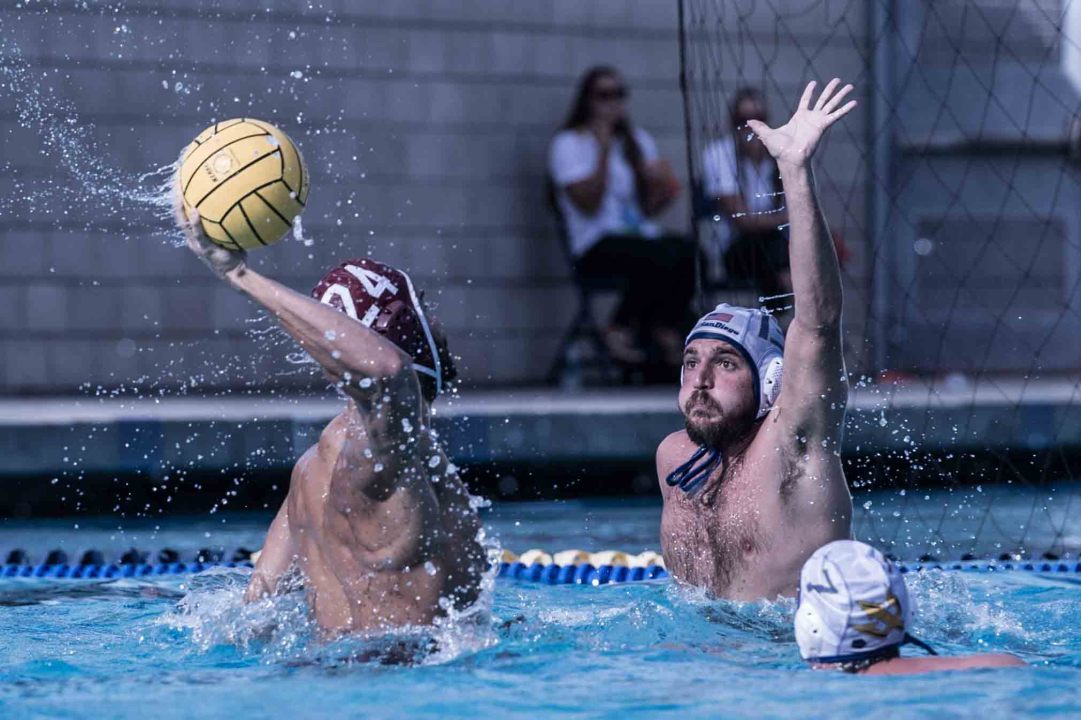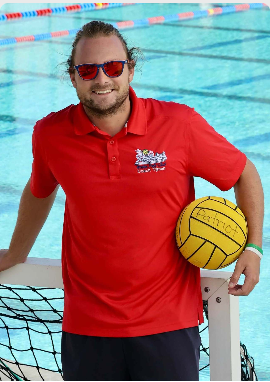Courtesy: Tijmen Egtberts
Water polo is one of the oldest sports currently played in the Olympics. Water polo is also a highly demanding physical endeavor.
One of the biggest factors of the sport is that the athletes have to wrestle with opponents as well as control, pass and shoot a ball while moving in water. This adds a certain difficulty that athletes do not have when performing on land: The lack of a solid base to stand on. While the arm and shoulder motion of a water polo shot looks similar to the motion of a baseball pitch or overhead throw in handball, the mechanics are vastly different. While athletes on land can ground themselves with a solid base of support, water polo athletes have to create a base by using the eggbeater technique with their legs. This technique allows them to find balance in the water and perform a throwing motion, much like the baseball and handball player.
For the rest of this analysis, the eggbeater technique has been taken as a constant. This is because it is a technique that is, while important, not particularly relevant to the throwing motion itself. The throwing motion consists of ‘rotation of the pelvis hip, rotation of the shoulders, a variation of angles of the elbow and wrist’, By combining these, a water polo athlete is able to throw the ball fast and accurate.
Most goals are scored from a similar motion, with similar throwing velocities. The position in the pool does not matter significantly, however, the one position that has a different mechanic is the center attacker position. The mechanics of a shot from the center attacker position are different, because he or she spends most of their time with the back to the goal.
The throwing motion will be analyzed by dissecting the following steps: Preparation, Rotation, and Release.
In the preparation phase, the athlete picks up the ball by placing his hand on top and putting pressure on the ball. He or she then rotates the hand under the ball.
“This lift was found to produce a higher ball velocity in a group of elite players compared to the lift from underneath where the hand is placed under the ball and the ball is raised directly from the water”. The trunk should be rotated away from the goal, with the shoulders almost perpendicular to the goal. The ‘mean elbow angle was 107º for elite male players while the ball was held on average 19 cm above and 33 cm behind the ear’. “The elbow angle showed significantly greater flexion for females (85°) than males (107°)”.
The second phase is the Rotation Phase. During this phase, most of the force is created to give the ball the maximum throwing velocity. The rotation initiates with the hips. “ The trunk starts the throw in a position of hyperextension and moves into 20 degrees of flexion during the throw”. With this rotation comes the rotation of the shoulders. During this rotation, the arm and ball are left behind. The shoulders move in lateral rotation, with the elbow flexed and the ball resting in the palm of the hand.
The final phase of the throwing motion is the release. During the release, the hand and elbow pass the shoulders for the first time. “ The shoulder is medially rotated and horizontally adducted by the anterior shoulder muscles, the elbow is moved toward extension and the lower arm pronates to apply additional force and spin to the ball. The range of motion of medial rotation during the throw has been reported to range from 40 to 80 degrees, with velocities approaching 500 deg/s”. “The amount of elbow extension during the forward swing was 48° for both groups; however, the females actually released the ball with the forearm vertical (89°) compared to the male forearm angle of 78°.”
The wrist motion is a key aspect of the throw as a whole as well. The wrist motion does not only provide extra velocity, but it also allows for the accuracy that is necessary for a good shot. “From rear point to release, the wrist joint of the female players flexed from a rear point angle of 158° to 148° at release. The wrist movement for male subjects was different from the females in that it flexed from 162° to 147°, 0.10 s prior to release and then extended to 159° at palmar release before again flexing to 156° at release”.
References
- Alexander, M., Hayward, J., & Honish, A. (2010, October). Water Polo: A Biomechanical Analysis of The Shot. Sports Biomechanics Lab of University of Manitoba. Retrieved March 26, 2019, from https://umanitoba.ca/faculties/kinrec/hlhpri/media/water_polo_shot.pdf
- Elliott, B. C., & Armour, J. (2009). The penalty throw in water polo: A cinematographic analysis. Journal of Sports Sciences, 6(2), 103-114. doi:10.1080/02640418808729801
- Melchiorri, G. Vierro, V. Triossi, T. De Sanctis, D. Padua, E. Salvati, A. Galvani, C. Bonifazi, M.
- Del Blanco, R. Trancredi, V. Water polo throwing velocity and kinematics: differences between competitive levels in male players. The Journal of Sports Medicine and Physical Fitness. 2015 Nov;55(11):1265-71. Epub 2014 Nov 4.
- A. Abraldes, H. Vila, C. Ferragut, N. Rodriguez, R. Fernandes. (2012). Throwing Velocity and Efficacy During Water Polo Matches. The Open Sports Sciences Journal, 5(1), 141-145. doi:10.2174/1875399×01205010141
- Smith, H. K. (1998). Applied physiology of water polo. Sports Medicine, 26(5), pp. 317-334. https://doi.org/10.2165/00007256-199826050-00003
 ABOUT TIJMEN EGTBERTS
ABOUT TIJMEN EGTBERTS
Coach Tijmen Egtberts was born and raised in The Netherlands. He started playing competitive water polo at the age of 8. His talent got recognized at Santa Rosa Junior College where he played for two years and was added to the coaching staff for one year as well. Tijmen continued his education at Concordia University – Irvine where he played water polo for one year and was Senior Captain of the swim team his final year. He graduated in 2016 with Bachelor’s degrees in sports management and psychology. He also holds Master’s Degrees in Coaching and Athletic Administration (MCAA), Business Administration (MBA) and Coaching and Exercise Sciences (MCSE). As a coach, Tijmen has 14 years of experience in coaching and in 2017 he coached a 10U team that won the gold division at NJO’s. In 2019 his team from Patriot Aquatics got 3rd place and in 2021 Tijmen coached both 10u girls and 10u mixed to become national champions. That was the first time in USA water polo history two teams from the same club won JOs at the 10u level. That was followed up by another National championship in 2022. Coach Tijmen is looking to bring the first ‘three-peat’ in USA water polo history with his 10u team this 2023 season.


I’m jealous of those kids: they have a ball at practice. My coach was a swimming coach and he got the waterpolo coaching position because it was an opening and he had some connections with administration. The only thing that he taught us about the game was to swim fast and to have one or more extra players at attack. And surprisingly this strategy worked. We were the best team in our kids league. But we hated our practices, there was no satisfaction of seeing the ball in goal net after your throwing. And that was the dream and the reason of all of us to come to this game at first place.